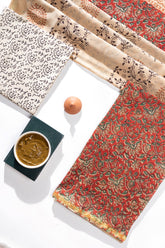The monsoon season brings with it a unique set of challenges for textile care, particularly for delicate handloom fabrics like Begumpuri cotton sarees. These exquisite handwoven treasures from Bengal require special attention during humid weather to maintain their beauty, integrity, and longevity. Whether you're a seasoned saree collector or a newcomer to the world of traditional Indian textiles, this comprehensive guide will equip you with expert begumpuri saree care techniques and proven cotton saree storage monsoon strategies.
Understanding proper begumpuri saree maintenance is crucial for preserving these cultural artifacts that represent centuries of weaving tradition. The high humidity levels during monsoon season can wreak havoc on natural fibers, making it essential to implement a thorough handloom saree care guide that addresses the specific needs of cotton textiles.
Understanding Begumpuri Cotton Sarees and Their Unique Properties
The Heritage of Begumpuri Weaving
Begumpuri sarees originate from the town of Begumpur in West Bengal, where skilled artisans have perfected the art of cotton weaving for generations. These handloom masterpieces are characterized by their lightweight texture, breathable weave, and distinctive patterns that make them ideal for India's tropical climate. The loose, airy construction that makes these sarees so comfortable also requires specific care techniques to maintain their structural integrity.
The natural cotton fibers used in Begumpuri sarees are particularly susceptible to moisture-related issues during monsoon season. Understanding the fabric's properties is the first step in implementing effective cotton saree preservation methods that will keep your collection pristine for years to come.
Why Monsoon Care Matters for Cotton Textiles
Cotton is a natural fiber that readily absorbs moisture from the environment. During monsoon season, when humidity levels can exceed 80%, cotton fabrics face several challenges:
- Moisture absorption leading to mold and mildew growth
- Color bleeding and fading
- Fabric stiffening and texture changes
- Insect attraction and pest infestations
- Unpleasant odors and bacterial growth
These issues make specialized handloom fabric care essential for maintaining the quality and appearance of your Begumpuri sarees throughout the rainy season.
Essential Pre-Monsoon Preparation for Your Begumpuri Saree Collection
Inventory and Assessment
Before the monsoon season begins, conduct a thorough inventory of your Begumpuri saree collection. Examine each piece for:
- Existing stains or discoloration
- Loose threads or minor damage
- Signs of previous moisture damage
- Areas requiring immediate attention
This assessment allows you to address any issues before they worsen in humid conditions, ensuring your monsoon clothing storage strategy is built on a solid foundation.
Pre-Storage Cleaning Protocol
Every saree must be completely clean and dry before storage. Follow these steps for optimal natural fiber maintenance:
Step 1: Gentle Inspection Examine each saree under good lighting to identify any stains, spots, or areas requiring special attention.
Step 2: Spot Treatment Address minor stains immediately using a mixture of cold water and mild detergent. Avoid harsh chemicals that can damage the natural cotton fibers.
Step 3: Complete Washing (If Necessary) For sarees requiring full washing, use the gentle hand-washing method detailed in our washing section below.
Step 4: Thorough Drying Ensure complete drying in a well-ventilated area away from direct sunlight before proceeding to storage.
How to Store Begumpuri Cotton Sarees During Monsoon: Expert Storage Solutions
Choosing the Right Storage Location
The location of your saree storage significantly impacts their preservation during monsoon season. Implement these best practices for begumpuri cotton saree preservation:
Optimal Storage Conditions:
- Temperature: 18-22°C (64-72°F)
- Humidity: Below 50% relative humidity
- Air circulation: Good ventilation without direct airflow
- Light exposure: Minimal to prevent fading
- Pest control: Regular monitoring and natural deterrents
Avoid These Storage Locations:
- Basements or ground-level areas prone to flooding
- Attics with poor ventilation
- Areas near bathrooms or kitchens
- Spaces with direct sunlight exposure
- Closets without proper air circulation
Storage Container Selection
The right storage containers are crucial for protecting begumpuri sarees from humidity and moisture. Consider these options:
Breathable Storage Solutions:
- Cotton saree bags: Allow air circulation while protecting from dust
- Muslin covers: Natural fiber covers that prevent moisture buildup
- Wooden chests: With proper ventilation holes
- Bamboo storage boxes: Naturally antimicrobial and moisture-resistant
Avoid These Materials:
- Plastic bags: Trap moisture and promote mold growth
- Sealed containers: Without ventilation
- Cardboard boxes: Can absorb moisture and deteriorate
Advanced Storage Techniques
Implement these professional saree folding techniques for optimal space utilization and fabric protection:
Method 1: The Traditional Fold
- Lay the saree flat on a clean, dry surface
- Fold lengthwise in half, ensuring the pallu is protected
- Create gentle accordion folds every 12-18 inches
- Place acid-free tissue paper between folds
- Store in a breathable container with silica gel packets
Method 2: The Roll Method
- Lay the saree flat with the pallu face down
- Place a cotton cloth or muslin sheet underneath
- Roll gently from the plain end toward the pallu
- Secure with cotton ties (never rubber bands)
- Store rolled sarees vertically to minimize pressure
Method 3: The Hanging Method (For Short-Term Storage)
- Use padded hangers to prevent creasing
- Hang in a well-ventilated closet with cedar blocks
- Cover with breathable cotton covers
- Rotate hanging position monthly
Begumpuri Handloom Saree Care and Maintenance Tips
Washing Guidelines for Cotton Sarees
Proper washing is fundamental to begumpuri saree washing and drying techniques. Follow these expert recommendations:
Pre-Wash Preparation:
- Color testing: Test a small, inconspicuous area for color fastness
- Stain treatment: Address spots before full washing
- Water temperature: Use cool water (below 30°C/86°F)
- Detergent selection: Choose mild, pH-neutral detergents
Hand Washing Process:
- Fill a large basin with cool water
- Add a small amount of mild detergent
- Gently immerse the saree without bunching
- Swish gently for 2-3 minutes
- Focus on stained areas with light rubbing
- Rinse thoroughly with clean water
- Gently squeeze out excess water without wringing
Machine Washing (When Necessary):
- Use delicate cycle with cold water
- Place saree in a mesh laundry bag
- Use gentle detergent designed for handloom fabrics
- Never use fabric softeners or bleach
Drying Techniques for Monsoon Season
Proper drying is critical for monsoon storage guide for begumpuri cotton sarees:
Indoor Drying Methods:
- Flat drying: Lay on absorbent towels in a ventilated room
- Hanging: Use padded hangers in a well-ventilated space
- Drying racks: Ensure good air circulation around the fabric
- Dehumidifier assistance: Use in poorly ventilated spaces
Outdoor Drying Considerations:
- Shade drying: Never expose to direct sunlight
- Weather monitoring: Bring indoors immediately if rain threatens
- Air circulation: Choose breezy but sheltered locations
- Quick drying: Monitor closely to prevent over-drying
How to Prevent Mold on Begumpuri Handloom Sarees
Understanding Mold Prevention
Mold prevention is crucial for maintaining your collection's integrity. Implement these textile conservation methods:
Environmental Controls:
- Humidity monitoring: Use hygrometers to track moisture levels
- Ventilation improvement: Install exhaust fans in storage areas
- Air circulation: Use fans to prevent stagnant air
- Temperature regulation: Maintain consistent, cool temperatures
Natural Mold Prevention Methods:
- Neem leaves: Place dried neem leaves in storage areas
- Activated charcoal: Absorbs excess moisture naturally
- Cloves: Natural antimicrobial properties
- Turmeric sachets: Traditional Indian preservation method
Moisture Control Strategies
Implement these humidity protection textiles strategies:
Desiccant Solutions:
- Silica gel packets: Place in storage containers
- Calcium chloride: Industrial-grade moisture absorbers
- Activated charcoal: Natural moisture and odor control
- Rice sachets: Traditional moisture absorbers
Mechanical Solutions:
- Dehumidifiers: For storage rooms
- Moisture meters: To monitor humidity levels
- Exhaust fans: For air circulation
- Air conditioning: For climate control
Long-Term Storage Solutions for Begumpuri Cotton Sarees
Seasonal Storage Rotation
Implement a systematic approach to seasonal clothing storage:
Quarterly Inspection Schedule:
- Spring: Complete cleaning and initial storage setup
- Summer: Mid-season inspection and humidity monitoring
- Monsoon: Active monitoring and maintenance
- Winter: Assessment and preparation for next season
Rotation Practices:
- Fabric airing: Monthly exposure to fresh air
- Position changes: Alternate folding patterns
- Container cleaning: Regular storage container maintenance
- Pest monitoring: Ongoing vigilance for insects
Creating a Saree Care Calendar
Establish a systematic saree wardrobe organization schedule:
Monthly Tasks:
- Humidity level checks
- Visual inspections for damage
- Airing of stored sarees
- Desiccant packet replacement
Quarterly Tasks:
- Deep cleaning of storage areas
- Rotation of saree positions
- Assessment of storage containers
- Pest control measures
Annual Tasks:
- Complete inventory assessment
- Professional cleaning consultation
- Storage system upgrades
- Insurance documentation updates
Professional Maintenance and Restoration
When to Seek Professional Help
Recognize when natural fabric protection requires professional intervention:
Signs Requiring Expert Care:
- Persistent odors despite cleaning
- Visible mold or mildew growth
- Significant color bleeding or fading
- Structural damage to the weave
- Insect infestations
Professional Services:
- Textile conservation specialists
- Traditional handloom restoration experts
- Museum-quality preservation services
- Specialized cleaning facilities
Preventive Professional Care
Consider these professional handwoven saree longevity services:
Annual Professional Cleaning:
- Deep cleaning methods not possible at home
- Specialized stain removal techniques
- Fabric conditioning treatments
- Structural integrity assessments
Consultation Services:
- Storage optimization advice
- Climate control recommendations
- Pest management strategies
- Insurance and documentation guidance
Troubleshooting Common Monsoon Storage Issues

Dealing with Moisture Damage
Address moisture-related problems immediately:
Mild Moisture Exposure:
- Remove from storage immediately
- Air dry in well-ventilated area
- Inspect for mold or mildew
- Clean if necessary before re-storage
Severe Moisture Damage:
- Separate affected sarees
- Professional assessment recommended
- Isolate to prevent spread
- Document damage for insurance purposes
Odor Management
Combat musty odors with these techniques:
Natural Odor Removal:
- Baking soda: Absorbs odors naturally
- White vinegar: Neutralizes musty smells
- Activated charcoal: Long-term odor control
- Fresh air exposure: Regular airing sessions
Prevention Strategies:
- Proper drying before storage
- Regular monitoring and rotation
- Natural fresheners in storage areas
- Immediate attention to moisture issues
Technology and Modern Storage Solutions
Digital Monitoring Systems
Utilize modern technology for textile maintenance guide optimization:
Smart Humidity Monitors:
- Bluetooth-enabled sensors
- Smartphone app integration
- Automated alerts for humidity changes
- Historical data tracking
Climate Control Systems:
- Automated dehumidifiers
- Smart ventilation systems
- Temperature regulation devices
- Air quality monitoring
Documentation and Inventory Management
Maintain comprehensive records:
Digital Cataloging:
- Photograph each saree before storage
- Maintain detailed condition records
- Track cleaning and maintenance history
- Insurance documentation
Preventive Scheduling:
- Digital calendar reminders
- Automated maintenance alerts
- Seasonal task management
- Professional service scheduling
Regional Considerations for Monsoon Care
Adapting to Local Climate Conditions
Adjust your monsoon wardrobe management based on regional factors:
High Humidity Regions:
- Increased desiccant use
- More frequent inspections
- Enhanced ventilation requirements
- Stronger pest control measures
Moderate Humidity Areas:
- Standard storage protocols
- Regular monitoring
- Seasonal adjustments
- Preventive maintenance
Low Humidity Regions:
- Reduced desiccant needs
- Focus on dust protection
- Standard rotation schedule
- Minimal special precautions
Sustainable and Eco-Friendly Storage Practices
Natural Preservation Methods
Embrace environmentally conscious organic cotton care:
Traditional Techniques:
- Neem leaf sachets: Natural pest deterrent
- Turmeric protection: Antimicrobial properties
- Cedar blocks: Natural moth repellent
- Camphor tablets: Traditional preservation method
Modern Eco-Solutions:
- Bamboo storage containers
- Organic cotton storage bags
- Natural fiber desiccants
- Chemical-free cleaning products
Sustainable Storage Materials
Choose environmentally responsible storage solutions:
Renewable Materials:
- Bamboo organizers
- Organic cotton covers
- Recycled cardboard dividers
- Natural fiber padding
Reusable Solutions:
- Washable storage bags
- Refillable desiccant packets
- Modular storage systems
- Multi-purpose containers
Frequently Asked Questions About Begumpuri Saree Monsoon Care
Q: How often should I check my stored Begumpuri sarees during monsoon season?
A: During active monsoon season, inspect your stored sarees at least once every two weeks. Check for signs of moisture, unusual odors, or any changes in storage conditions. In high-humidity areas, weekly checks are recommended to catch potential issues early.
Q: Can I use regular plastic bags for emergency storage during monsoon?
A: Never use plastic bags for storing Begumpuri cotton sarees, even temporarily. Plastic traps moisture and creates ideal conditions for mold growth. Instead, use breathable cotton bags or muslin covers, even for short-term storage needs.
Q: What's the best way to remove musty odors from stored sarees?
A: For mild musty odors, air the sarees in a well-ventilated area for 24-48 hours. For persistent odors, try natural remedies like placing the sarees with activated charcoal or baking soda sachets. Severe odors may require professional cleaning.
Q: How do I know if my storage area has the right humidity level?
A: Use a digital hygrometer to monitor humidity levels. Ideal storage conditions maintain humidity below 50%. If levels consistently exceed 60%, consider using dehumidifiers or improving ventilation in your storage area.
Q: Should I wash my Begumpuri sarees before monsoon storage?
A: Yes, always ensure sarees are completely clean and dry before storage. Even minor stains or soil can attract insects and promote mold growth in humid conditions. Professional cleaning is recommended for valuable or delicate pieces.
Q: What natural ingredients can I use to prevent insect damage?
A: Neem leaves, dried lavender, cloves, and cedar blocks are excellent natural insect deterrents. Avoid using camphor directly on sarees, as it can cause chemical reactions with certain dyes. Instead, place it in small sachets within storage areas.
Q: How do I handle sarees that have been exposed to flood water?
A: Flood-damaged sarees require immediate professional attention. Remove them from contaminated areas, document the damage for insurance purposes, and consult textile conservation experts. Never attempt to clean flood-damaged valuable textiles at home.
Q: Can I store different types of sarees together?
A: While cotton sarees can generally be stored together, avoid mixing different fiber types or colors that may bleed. Use acid-free tissue paper between sarees and ensure adequate space for air circulation around each piece.
Building Your Begumpuri Saree Collection: Investment and Care
Choosing Quality Pieces
When building your collection, prioritize quality over quantity:
Quality Indicators:
- Authentic handloom construction
- Natural dye colorants
- Proper finishing techniques
- Documented provenance
Investment Considerations:
- Craftsman reputation
- Regional authenticity
- Unique design elements
- Condition and preservation state
Documentation and Valuation
Maintain proper records for your collection:
Essential Documentation:
- Purchase receipts and certificates
- Artisan information and provenance
- Detailed condition reports
- Professional appraisals
Insurance Considerations:
- Specialized textile insurance
- Regular valuation updates
- Comprehensive photographic records
- Professional storage documentation
Conclusion: Preserving Bengali Heritage Through Proper Care
Caring for your Begumpuri cotton sarees during monsoon season is more than just textile maintenance—it's about preserving cultural heritage and honoring the artisans who created these beautiful pieces. By implementing the comprehensive care strategies outlined in this guide, you ensure that your collection remains a source of pride and beauty for generations to come.
The key to successful begumpuri saree care lies in understanding the unique properties of cotton handloom textiles and adapting your maintenance routine to address the specific challenges of monsoon weather. From proper cotton saree storage monsoon techniques to effective humidity protection textiles strategies, every aspect of care contributes to the longevity and beauty of your collection.
Remember that begumpuri saree maintenance is an ongoing process that requires attention, patience, and respect for the craftsmanship these textiles represent. By following the best practices for begumpuri cotton saree preservation detailed in this guide, you become a steward of Bengali textile tradition, ensuring that these magnificent handloom creations continue to inspire and delight for years to come.
Whether you're storing a single cherished saree or managing an extensive collection, the principles remain the same: proper preparation, appropriate storage conditions, regular monitoring, and prompt attention to any issues that arise. With these monsoon storage guide for begumpuri cotton sarees techniques, you can weather any storm while keeping your textiles in pristine condition.
Your Begumpuri sarees represent more than just clothing—they are tangible connections to centuries of weaving tradition, skilled craftsmanship, and cultural heritage. By mastering the art of handloom saree care guide practices, you honor this legacy while ensuring that future generations can appreciate the beauty and significance of these extraordinary textiles.









